Localities of the Cambrian:
The Marble Mountains
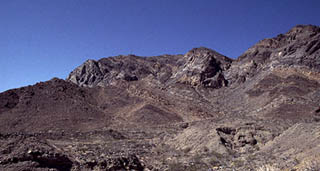


The Marble Mountains are a rather small mountain range located in one of the harshest, driest parts of the Mojave Desert, in southeastern California near the tiny towns of Chambless and Cadiz. What makes the Marble Mountains especially attractive to paleontologists is the comparatively rich Cambrian fossil biota which can be found in a particular rock layer, the Latham Shale, that is well-exposed in the southern part of the range, as well as in some nearby ranges such as the Bristol Mountains. The Latham Shale and the rock layers below and above it comprise a well-studied section of Lower and Middle Cambrian strata, which extends, with some variation, over a large part of the southern Mojave Desert.
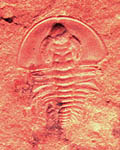
|
The dominant fossils in the Latham Shale are trilobites in the Olenellina. Olenellids, unlike almost all other trilobites, lack facial sutures, and the cephalon or head was molted as a single piece. Olenellid heads are common in the Latham Shale. Complete trilobites are more rare. Olenellids were restricted to the Early Cambrian, and the olenellids in the Latham Shale are relatively late in the group's history. Shown at left is a complete specimen of the genus Olenellus, probably O. clarki. (The author of this exhibit found this particular specimen on January 1, 2000, and has been known to refer to it as his "personal Y2K bug.") |
|
Although trilobites are the most common and most popular fossils in the Latham Shale, they are not the only fossils that have been found there. Several species of brachiopod have been found in the Latham Shale, including some of the earliest articulate brachiopods (brachiopods with hinge teeth) known from the fossil record. Hyoliths, conical shells that bore hinged "lids" or opercula in life, are also found in the Latham Shale. One is shown at right; it may represent the genus Nevadatheca. (Mount 1974, 1980) Trace fossils left by worms and by trilobites are also fairly common. Much more rarely, eocrinoid echinoderms, segmented worms, soft-bodied algae, and the appendages of the giant Cambrian predator Anomalocaris have been found (Durham 1978; Mount 1980; Briggs and Mount 1982; Waggoner and Hagadorn 1999). |
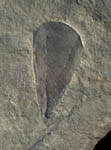
|
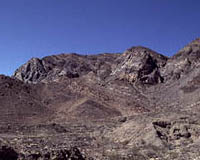
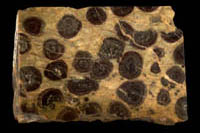
|
Fossils can also be found in the rock layers above and below the Latham Shale. (Click on the image at upper left to see a larger image of the area, or click here to see an image with the strata labeled.) Below the Latham Shale lies a thick layer of quartzite, the Zabriskie Quartzite, which has few body fossils, but often contains numerous fossilized vertical burrows (form genus Skolithus made by unknown organisms. The grayish layer above the Latham Shale, the Chambless Formation, is rich in oncolites, which are formed by cyanobacterial growth. Oncolites are very similar to stromatolites, but instead of forming columns, oncolites form nearly spherical growths. The image at lower left shows a slab of polished Chambless Limestone; the concentric "bull's-eye" pattern formed by algal growth is very apparent. The Chambless Formation is also rich in hyoliths and fragments of trilobites. Above the Chambless Formation, the shales and sandstones of the Cadiz Formation contain many trace fossils, and a few layers have fairly common trilobite remains. The lowest few feet of the Cadiz Formation contain olenellids and are therefore Lower Cambrian, but the bulk of the formation contains trilobites of Middle Cambrian aspect. (It should be noted that, elsewhere in the Mojave Desert, the Latham Shale, Chambless Formation, and Cadiz Formation are not considered to be separate, distinct formations; their equivalents elsewhere are grouped together as the Carrara Formation. See Palmer and Halley 1979.) On top of the Cadiz Formation lies a massive, cliff-forming layer of dolomite (magnesium carbonate) with few fossils, the Bonanza King Dolomite. |
Planning a trip to the Mojave Desert? The excellent Collecting Fossils in California Website has directions to one of the collecting sites in the Marble Mountains. No permit is currently necessary to collect...but don't forget to bring lots of water, lots of sunscreen, good hiking shoes, and a broad-brimmed hat. You'll need them.


